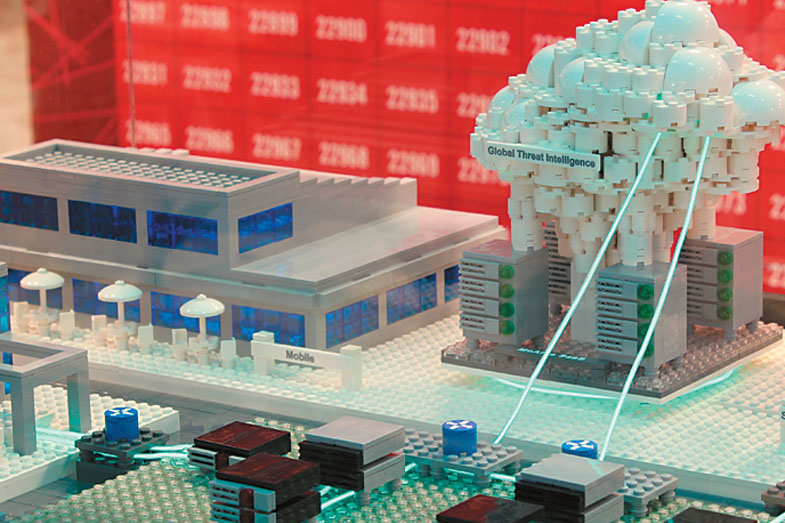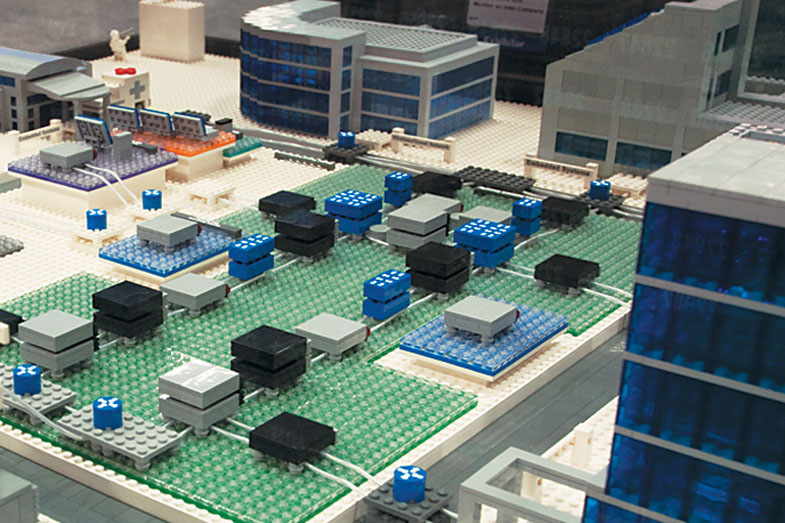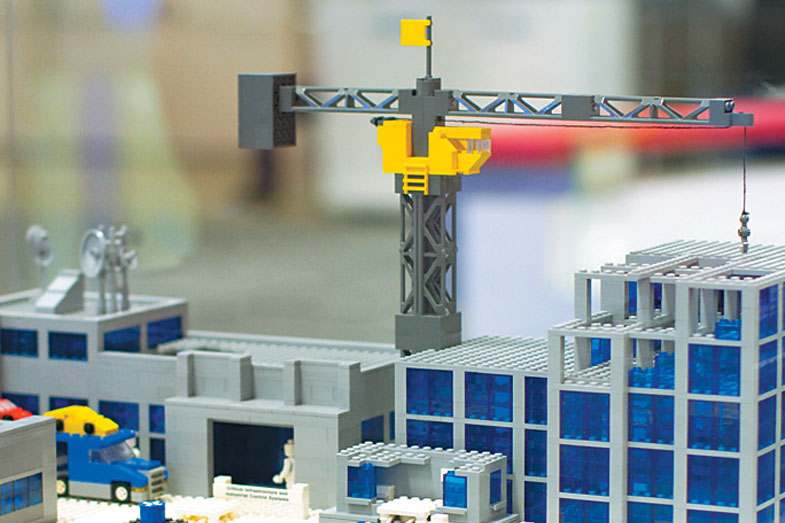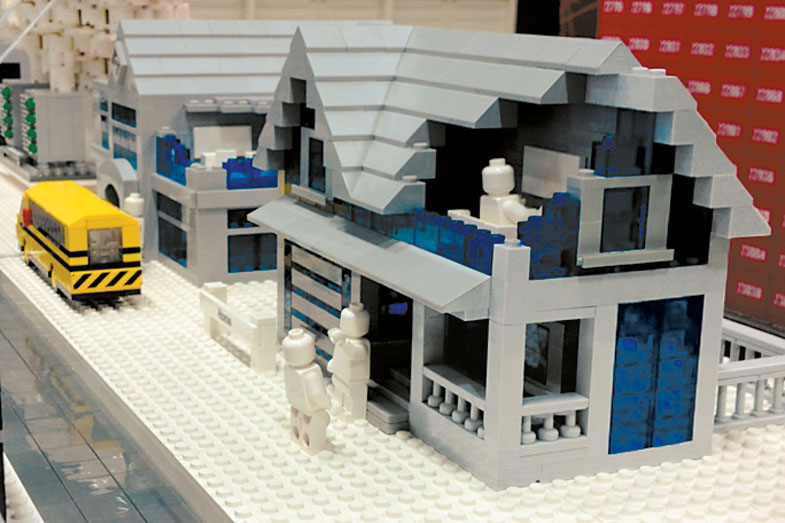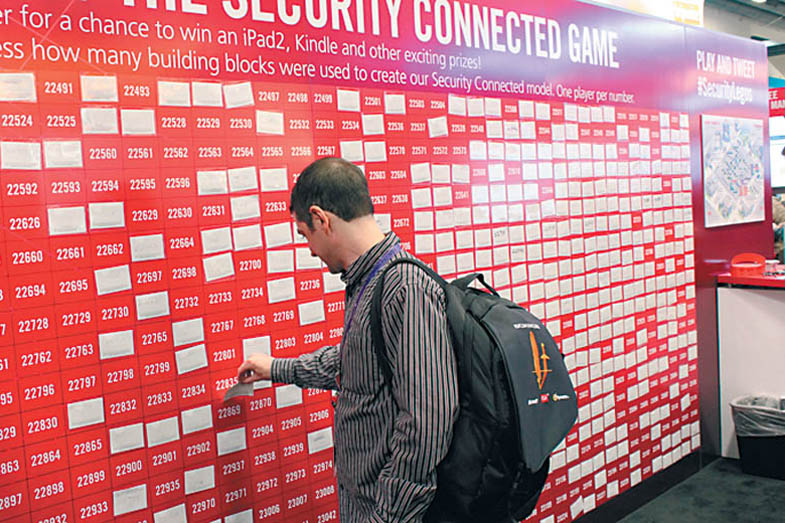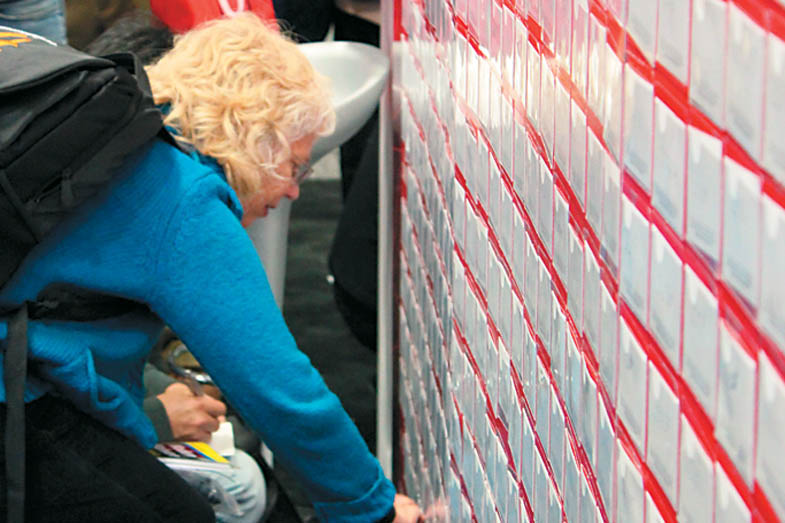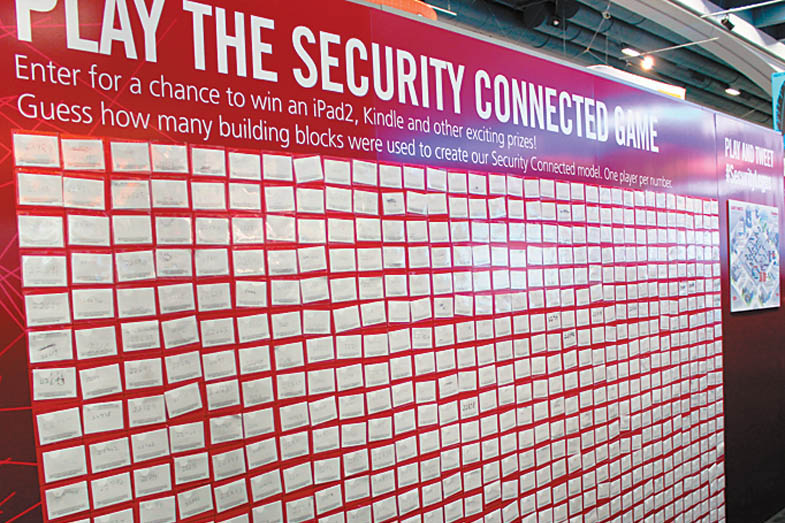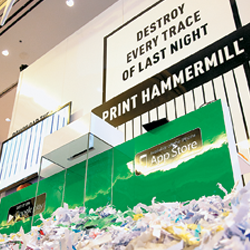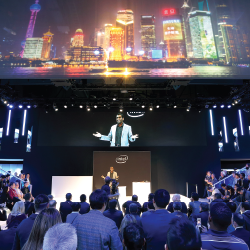|
McAfee's Building Blocks
McAfee Inc. builds a Lego city
to illustrate its Security Connected
product with child-like simplicity,
generating sales leads and
social-media buzz in the process. By Cynthya Porter

 ue to the increasing digitization of our world, most people now have two personas: Their flesh-and-blood selves walking the streets and entering brick-and-mortar buildings, and their digital avatars doing things like shopping on Amazon.com, conducting a little online banking, and socializing with friends. But while our human personas have learned to stay safe by locking our doors and avoiding sketchy neighborhoods, our digital selves often amble obliviously right into the arms of Internet muggers seeking to steal our life savings or even our identities.
Worldwide, losses from cybercrimes stretch well into the billions, but it isn't merely mega corporations that are targeted. Hackers and malware peddlers have cracked into the digital lives of a dizzying number of small-business owners and individuals who file more than 300,000 complaints a year with the Internet Crime Complaint Center. That number represents a 1,800-percent increase over the previous 10 years, making it clear that as our Internet presence grows, so too does the number of ways thieves find to rob us.
Founded in 1987, McAfee Inc. aims to protect computer systems and Internet information from digital bandits. In 2012, the company planned a major push for its product that contains a newly integrated suite of services called Security Connected, a framework that ties together security solutions for Web, network, cloud, and mobile platforms in myriad settings. RSA Conference, a cornerstone show for security professionals, presented the perfect place for McAfee to tout its new product, but company officials needed to find a way to illustrate their intangible offering in a tangibly understandable way.
LEGO LAND
To demonstrate how its Security Connected product is used in a typical city, McAfee Inc. hired a Lego artist to construct a diorama featuring banks, schools, a city hall, a hospital, and more.
"At these types of shows, technology people see the same things year after year," says Maricar Salud-Calantog, McAfee's events program manager. And in an industry where products lack physical form, informational graphics and digital learning stations are nom de rigueur for exhibits. If McAfee simply relied on the same, its booth would undoubtedly blend into the rows of tech products.
Salud-Calantog contemplated ways the company could boost itself out of the sameness of the show floor, and realized that the answer was not another elaborate technology display. The way to stand out, she mused, was to simplify the exhibit, give attendees a respite from digital presentations, and show them rather than tell them how Security Connected works. To that end, Salud-Calantog opted to take McAfee's incredibly complex product and display it in the most simplistic way possible – by building a miniature city and illustrating where the company's offerings are used.
Little City, Big Idea
Salud-Calantog enlisted the help of exhibit and event firm MC², and began brainstorming the blueprints for McAfee's mini city. The diorama-like display would show banks and schools and a city hall, as well as businesses, homes, a hospital, and public places where people might use their mobile phones to access information. Woven into that cityscape were filaments that extended from McAfee computer hubs in the center of the city through all the buildings, demonstrating the web of protection that McAfee threads through each of those places via Security Connected, and allowing attendees to easily visualize the scope and reach of the product.
The McAfee/MC² team didn't stop there. "We wanted to appeal to the curiosity of security professionals, to their technical nature, and we had to get the story to come alive," says Brendan Dooley, senior graphic designer at MC². The group wagered on the idea that the technical adults had likely once been engineering-minded children who whiled away hours constructing Lego models, and that a grown-up version of the same idea would be irresistibly interesting to them. So the team decided to have the city built of thousands of Legos, and then host an in-booth competition for attendees that centered on the whimsical structure. Thus, McAfee hoped to increase the average booth visit to 15 minutes, engage at least 700 people in the game, generate 35 hot leads, and stretch the impact of the city beyond the confines of RSA by mobilizing attendees to tweet about it in exchange for chances to win a prize.
Not surprisingly, Lego doesn't sell any 16-square-foot city kits, and while Legos have long been the busy work of children, this child-like idea was not a job for little hands. After a bit of Lego-related legwork, MC² tracked down one of just 10 Lego architects in the country capable of such a feat of micro-engineering.
Adam Tucker of Brickstructures Inc. spent four days in a Chicago warehouse creating the 4-by-4-foot display, which stood roughly 18 inches tall at its highest point. An award-winning, Lego-certified artist, Tucker incorporated working lights and 22,750 blocks into the structure before loading it onto a truck for the 2012 RSA Conference at the Moscone Center in San Francisco.
In the meantime, to promote the Lego city and the in-booth contests that would surround it, McAfee sent out an email the week before the show to entice RSA's 25,000 preregistered attendees to stop by the company's booth. The company also featured information about the display on the McAfee Security Connected blog, and teased information to media representatives attending RSA in an attempt to pique their interest.
Block Buster
When the show opened, McAfee's 30-by-50-foot booth had the expected informational graphics, learning stations, and a presentation theater, but it also had the Plexiglas-encased Lego city prominently featured along one aisle. On a wall behind the display, designers hung 748 clear vinyl envelopes containing numbers from 22,489 to 23,236. The team had devised a contest in which attendees could guess how many blocks the mini city contained, but it narrowed the field for guessing to ensure someone would actually select the correct number and win the grand prize iPad2 it planned to give away, as well as the runner-up prizes it had for the closest two numbers on either side of the exact figure.
To play the guessing game, attendees listened to a few minutes of introduction given by a staffer about Security Connected in a presentation area within the exhibit, then spent time examining the model to cultivate their guesses. While they ogled it, a staffer explained the various structures and how McAfee's product creates seamless protection between devices and locations. Hanging on a wall nearby, a detailed legend map elaborated on the city's buildings and the way McAfee's products could protect the information within them.
To log their guesses on how many Legos were used, attendees chose one of the numbers from the wall, wrote their contact information on a notecard, placed that card inside the envelope bearing their best guess, and hung the envelope back on the wall. McAfee capped the number of players at 748, and once a number was chosen, it was no longer available. By the last day of the show, every number had been spoken for. McAfee turned those entrants into leads, but also scanned an additional 30 badges of attendees who didn't get to play but still spent time in the booth learning about the display.
LEGO MY NUMBER
Attendees tried to guess the number of blocks used in McAfee's Lego city by choosing one of 748 numbers displayed on a wall. The person with the correct number won an iPad2.
Participants had to wait until the last day of the show to find out exactly how many Lego blocks were used, but McAfee offered chances to win daily drawings for smaller tech gadgets such as Kindles and iPod Nanos. To enter, attendees had to tweet or post a message on their Facebook walls stating, "I played the Lego Security Connected Game at McAfee RSA Booth 1117!" At the end of each show day, a staffer would randomly select winners from a list of posts and tweets, letting them know through the same social-media channels that they had a prize coming.
Some of McAfee's 17,000 Twitter followers not at RSA were also able to get in on the game when the company tweeted a photo of the model and invited people to guess the number of blocks. To qualify, followers had to use the hashtag #SecurityLegos, and though they were not eligible for the grand prize, the 80 tweeters who responded were entered into a drawing for a Kindle and an iPod Nano.
McAfee pushed word of the intriguing Lego cityscape through not only its Facebook and Twitter accounts, but also other social-media channels by sending photos from the booth to its Flickr page and adding a blog post during the trade show that explained the exhibit. In addition, McAfee hosted a happy-hour event for industry analysts and social-media influencers at which it promoted its new technology and engaging display. All told, the buzz McAfee's little city created was enormous, Dooley says, and attendees constantly swarmed the booth to sneak a peek at the company's Lego land.
Adding Up the Pieces
McAfee surpassed its goal of 700 game participants, with attendees claiming all 748 numbers available, and it held attendee attention for an average of 15 to 20 minutes during booth visits. Staffers scanned 780 badges in all, collecting 55 hot leads, more than 50 percent above McAfee's pre-show goal of 35.
In terms of social-media success, the Lego display brought McAfee the attention it was after. The company's Twitter following multiplied at a rate three times faster than it had prior to the show, and users were five times more engaged than before the event. In addition, the company's RSA photo album on Flickr received 2,000 views, and 500 people visited the McAfee Security Connected blog.
The campaign's appeal to people working in high-tech fields, Dooley says, was likely due to the utter simplicity of the entire idea. "The model presented a clever realization of McAfee's Security Connected product and offered a contrast between simple childhood building blocks and sophisticated security concepts," he says. A Lego city set the tone for simplicity, but even the number wall with its vinyl envelopes, handwritten entry cards, and lack of flashy digital signage offered something of a technology respite at a show where attendees are assailed by one technical display more complex than the next, aisle after aisle.
McAfee not only surpassed its exhibiting goals and propelled Security Connected into the market with a buzz, but also did so using a marketing promotion that cost just $15,000 to implement. This success did not come from trying to "out-tech" other exhibitors, but rather from showing them with child-like simplicity that when it comes to digital bodyguards, McAfee is the safest one to walk around the block with.E
|




 ue to the increasing digitization of our world, most people now have two personas: Their flesh-and-blood selves walking the streets and entering brick-and-mortar buildings, and their digital avatars doing things like shopping on Amazon.com, conducting a little online banking, and socializing with friends. But while our human personas have learned to stay safe by locking our doors and avoiding sketchy neighborhoods, our digital selves often amble obliviously right into the arms of Internet muggers seeking to steal our life savings or even our identities.
ue to the increasing digitization of our world, most people now have two personas: Their flesh-and-blood selves walking the streets and entering brick-and-mortar buildings, and their digital avatars doing things like shopping on Amazon.com, conducting a little online banking, and socializing with friends. But while our human personas have learned to stay safe by locking our doors and avoiding sketchy neighborhoods, our digital selves often amble obliviously right into the arms of Internet muggers seeking to steal our life savings or even our identities. 
